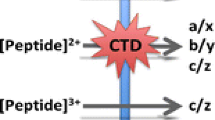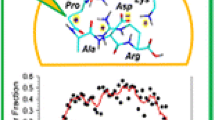Abstract
An N-terminal deuterohemin-containing hexapeptide (DhHP-6) was designed as a short peptide cytochrome c (Cyt c) mimetic to study the effect of N-terminal charge on peptide fragmentation pathways. This peptide gave different dissociation patterns than normal tryptic peptides. Upon collision-induced dissociation (CID) with an ion trap mass spectrometer, the singly charged peptide ion containing no added proton generated abundant and characteristic bn-44 ions instead of bn-28 (an) ions. Studies by high resolution mass spectrometry (HRMS) and isotope labeling indicate that elimination of 44 Da fragments from b ions occurs via two different pathways: (1) loss of CH3CHO (44.0262) from a Thr side chain; (2) loss of CO2 (43.9898) from the oxazolone structure in the C-terminus. A series of analogues were designed and analyzed. The experimental results combined with Density Functional Theory (DFT) calculations on the proton affinity of the deuteroporphyrin demonstrate that the production of these novel bn-44 ions is related to the N-terminal charge via a charge-remote rather than radical-directed fragmentation pathway.

ᅟ







Similar content being viewed by others
References
Aebersold, R., Goodlett, D.R.: Mass spectrometry in proteomics. Chem. Rev. 101, 269–296 (2001)
Seidler, J., Zinn, N., Boehm, M.E., Lehmann, W.D.: De novo sequencing of peptides by MS/MS. Proteomics 10, 634–649 (2010)
Medzihradszky, K.F., Chalkley, R.J.: Lessons in de novo peptide sequencing by tandem mass spectrometry. Mass Spectrom. Rev. 1–21 (2013). doi:10.1002/mas.21406
Escobar, H., Reyes-Vargas, E., Jensen, P.E., Delgado, J.C., Crockett, D.K.: Utility of characteristic QTOF MS/MS fragmentation for MHC class I peptides. J. Proteome Res. 10, 2494–2507 (2011)
Mouls, L., Aubagnac, J.L., Martinez, J., Enjalbal, C.: Low energy peptide fragmentations in an ESI-Q-Tof type mass spectrometer. J. Proteome Res. 6, 1378–1391 (2007)
Dongre, A.R., Jones, J.L., Somogyi, Á., Wysocki, V.H.: Influence of peptide composition, gas-phase basicity, and chemical modification on fragmentation efficiency: evidence for the mobile proton model. J. Am. Chem. Soc. 118, 8365–8374 (1996)
Paizs, B., Suhai, S.: Fragmentation pathways of protonated peptides. Mass Spectrom. Rev. 24, 508–548 (2005)
Tabb, D.L., Huang, Y., Wysocki, V.H., Yates, J.R.: Influence of basic residue content on fragment ion peak intensities in low-energy collision-induced dissociation spectra of peptides. Anal. Chem. 76, 1243–1248 (2004)
Huang, Y., Triscari, J.M., Tseng, G.C., Pasa-Tolic, L., Lipton, M.S., Smith, R.D., Wysocki, V.H.: Statistical characterization of the charge state and residue dependence of low-energy CID peptide dissociation patterns. Anal. Chem. 77, 5800–5813 (2005)
Laskin, J., Yang, Z., Song, T., Lam, C., Chu, I.K.: Effect of the basic residue on the energetics, dynamics, and mechanisms of gas-phase fragmentation of protonated peptides. J. Am. Chem. Soc. 132, 16006–16016 (2010)
Tsaprailis, G., Nair, H., Somogyi, Á., Wysocki, V.H., Zhong, W., Futrell, J.H., Summerfield, S.G., Gaskell, S.J.: Influence of secondary structure on the fragmentation of protonated peptides. J. Am. Chem. Soc. 121, 5142–5154 (1999)
Schweppe, R.E., Haydon, C.E., Lewis, T.S., Resing, K.A., Ahn, N.G.: The characterization of protein post-translational modifications by mass spectrometry. Acc. Chem. Res. 36, 453–461 (2003)
Sprung, R., Chen, Y., Zhang, K., Cheng, D., Zhang, T., Peng, J., Zhao, Y.: Identification and validation of eukaryotic aspartate and glutamate methylation in proteins. J. Proteome Res. 7, 1001–1006 (2008)
Palumbo, A.M., Tepe, J.J., Reid, G.E.: Mechanistic insights into the multistage gas-phase fragmentation behavior of phosphoserine- and phosphothreonine-containing peptides. J. Proteome Res. 7, 771–779 (2008)
Reid, G.E., Roberts, K.D., Kapp, E.A., Simpson, R.J.: Statistical and mechanistic approaches to understanding the gas-phase fragmentation behavior of methionine sulfoxide containing peptides. J. Proteome Res. 3, 751–759 (2004)
Harrison, A.G.: To b or not to b: the ongoing saga of peptide b ions. Mass Spectrom. Rev. 28, 640–654 (2009)
Polfer, N.C., Oomens, J., Suhai, S., Paizs, B.: Spectroscopic and theoretical evidence for oxazolone ring formation in collision-induced dissociation of peptides. J. Am. Chem. Soc. 127, 17154–17155 (2005)
Gu, C., Tsaprailis, G., Breci, L., Wysocki, V.H.: Selective gas-phase cleavage at the peptide bond C-terminal to aspartic acid in fixed-charge derivatives of Asp-containing peptides. Anal. Chem. 72, 5804–5813 (2000)
Wang, B., Shang, J.Z., Qin, Y.J., Yan, B.N., Guo, X.H.: Differentiation of α-or β-aspartic isomers in the heptapeptides by the fragments of [M+ Na]+ using ion trap tandem mass spectrometry. J. Am. Soc. Mass Spectrom. 22, 1453–1462 (2011)
Switzar, L., Giera, M., Niessen, W.M.: Protein digestion: an overview of the available techniques and recent developments. J. Proteome Res. 12, 1067–1077 (2013)
Bythell, B.J., Csonka, I.P., Suhai, S., Barofsky, D.F., Paizs, B.: Gas-phase structure and fragmentation pathways of singly protonated peptides with N-terminal arginine. J. Phys. Chem. B 114, 15092–15105 (2010)
Bythell, B.J., Suhai, S., Somogyi, Á., Paizs, B.: Proton-driven amide bond-cleavage pathways of gas-phase peptide ions lacking mobile protons. J. Am. Chem. Soc. 131, 14057–14065 (2009)
Guan, S., Li, P., Luo, J., Li, Y., Huang, L., Wang, G., Zhu, L., Fan, H., Li, W., Wang, L.: A deuterohemin peptide extends lifespan and increases stress resistance in Caenorhabditis elegans. Free Radic. Res. 44, 813–820 (2010)
He, F., Hendrickson, C.L., Marshall, A.G.: Unequivocal determination of metal atom oxidation state in naked heme proteins: Fe (III) myoglobin, Fe (III) cytochrome c, Fe (III) cytochrome b5, and Fe (III) cytochrome b5 L47R. J. Am. Soc. Mass Spectrom. 11, 120–126 (2000)
Yang, F., Bogdanov, B., Strittmatter, E.F., Vilkov, A.N., Gritsenko, M., Shi, L., Elias, D.A., Ni, S., Romine, M., Paša-Tolic, L.: Characterization of purified c-type heme-containing peptides and identification of c-type heme-attachment sites in Shewanella oneidenis cytochromes using mass spectrometry. J. Proteome Res. 4, 846–854 (2005)
Pashynska, V.A., Van den Heuvel, H., Claeys, M., Kosevich, M.V.: Characterization of noncovalent complexes of antimalarial agents of the artemisinin-type and FE (III)-heme by electrospray mass spectrometry and collisional activation tandem mass spectrometry. J. Am. Soc. Mass Spectrom. 15, 1181–1190 (2004)
Tureček, F.: Copper-biomolecule complexes in the gas phase. The ternary way. Mass Spectrom. Rev. 26, 563–582 (2007)
Barlow, C.K., McFadyen, W.D., O’Hair, R.A.: Formation of cationic peptide radicals by gas-phase redox reactions with trivalent chromium, manganese, iron, and cobalt complexes. J. Am. Chem. Soc. 127, 6109–6115 (2005)
Chu, I.K., Rodriquez, C.F., Lau, T.C., Hopkinson, A.C., Siu, K.M.: Molecular radical cations of oligopeptides. J. Phys. Chem. B 104, 3393–3397 (2000)
Breuker, K., McLafferty, F.W.: Native electron capture dissociation for the structural characterization of noncovalent interactions in native cytochrome c**. Angew. Chem. 115, 5048–5052 (2003)
Chan, W.C., White, P.D. (eds.): Fmoc solid phase peptide synthesis—a practical approach. Oxford University Press Inc, New York (2000)
Bleiholder, C., Paizs, B., Suhai, S.: Revising the proton affinity scale of the naturally occurring α-amino acids. J. Am. Soc. Mass Spectrom. 17, 1275–1281 (2006)
Frisch, M.J., Trucks, G.W., Schlegel, H.B., Scuseria, G.E., Robb, M.A., Cheeseman, J.R., Scalmani, G., Barone, V., Mennucci, B., Petersson, G.A., Nakatsuji, H., Caricato, M., Li, X., Hratchian, H.P., Izmaylov, A.F., Bloino, J., Zheng, G., Sonnenberg, J.L., Hada, M., Ehara, M., Toyota, K., Fukuda, R., Hasegawa, J., Ishida, M., Nakajima, T., Honda, Y., Kitao, O., Nakai, H., Vreven, T., Montgomery Jr., J.A., Peralta, J.E., Ogliaro, F., Bearpark, M., Heyd, J.J., Brothers, E., Kudin, K.N., Staroverov, V.N., Kobayashi, R., Normand, J., Raghavachari, K., Rendell, A., Burant, J.C., Iyengar, S.S., Tomasi, J., Cossi, M., Rega, N., Millam, N.J., Klene, M., Knox, J.E., Cross, J.B., Bakken, V., Adamo, C., Jaramillo, J., Gomperts, R., Stratmann, R.E., Yazyev, O., Austin, A.J., Cammi, R., Pomelli, C., Ochterski, J.W., Martin, R.L., Morokuma, K., Zakrzewski, V.G., Voth, G.A., Salvador, P., Dannenberg, J.J., Dapprich, S., Daniels, A.D., Farkas, Ö., Foresman, J.B., Ortiz, J.V., Cioslowski, J., Fox, D.: Gaussian 09, revision A.01. Gaussian, Inc, Wallingford (2009)
MacKerell, A.D., Bashford, D., Bellott, M., Dunbrack, R.L., Evanseck, J.D., Field, M.J., Fischer, S., Gao, J., Guo, H., Ha, S., Joseph-McCarthy, D., Kuchnir, L., Kuczera, K., Lau, F.T.K., Mattos, C., Michnick, S., Ngo, T., Nguyen, D.T., Prodhom, B., Reiher, W.E., Roux, B., Schlenkrich, M., Smith, J.C., Stote, R., Straub, J., Watanabe, M., Wiorkiewicz-Kuczera, J., Yin, D., Karplus, M.: All-atom empirical potential for molecular modeling and dynamics studies of proteins. J. Phys. Chem. B 102, 3586–3616 (1998)
Discovery Studio 2.5; Accelrys Inc.: San Diego (2009)
Allen, J.M., Racine, A.H., Berman, A.M., Johnson, J.S., Bythell, B.J., Paizs, B., Glish, G.L.: Why are a3 ions rarely observed? J. Am. Soc. Mass Spectrom. 19, 1764–1770 (2008)
Sinha, R.K., Erlekam, U., Bythell, B.J., Paizs, B., Maître, P.: Diagnosing the protonation site of b2 peptide fragment ions using IRMPD in the X–H (X = O, N, and C) stretching region. J. Am. Soc. Mass Spectrom. 22, 1645–1650 (2011)
Tsaprailis, G., Nair, H., Zhong, W., Kuppannan, K., Futrell, J.H., Wysocki, V.H.: A mechanistic investigation of the enhanced cleavage at histidine in the gas-phase dissociation of protonated peptides. Anal. Chem. 76, 2083–2094 (2004)
Farrugia, J.M., Taverner, T., O’Hair, R.A.: Side-chain involvement in the fragmentation reactions of the protonated methyl esters of histidine and its peptides. Int. J. Mass Spectrom. 209, 99–112 (2001)
Barton, S.J., Whittaker, J.C.: Review of factors that influence the abundance of ions produced in a tandem mass spectrometer and statistical methods for discovering these factors. Mass Spectrom. Rev. 28, 177–187 (2009)
Reid, G.E., Simpson, R.J., O’Hair, R.A.: Leaving group and gas phase neighboring group effects in the side chain losses from protonated serine and its derivatives. J. Am. Soc. Mass Spectrom. 11, 1047–1060 (2000)
Neta, P., Pu, Q.L., Yang, X., Stein, S.E.: Consecutive neutral losses of H2O and C2H4O from N-terminal Thr–Thr and Thr–Ser in collision-induced dissociation of protonated peptides Position dependent water loss from single Thr or Ser. Int. J. Mass Spectrom. 267, 295–301 (2007)
Serafin, S.V., Zhang, K., Aurelio, L., Hughes, A.B.., Morton, T.H.: Decomposition of protonated threonine, its stereoisomers, and its homologues in the gas phase: evidence for internal backside displacement. Org. Lett. 6, 1561–1564 (2004)
Laskin, J., Yang, Z., Ng, C.M., Chu, I.K.: Fragmentation of α-radical cations of arginine-containing peptides. J. Am. Soc. Mass Spectrom. 21, 511–521 (2010)
Singh, G.S., D’hooghe, M., Kimpe, N.D.: Synthesis and reactivity of C-heteroatom-substituted aziridines. Chem. Rev. 107, 2080–2135 (2007)
Cooper, T.J., Talaty, E.R., Van Stipdonk, M.J.: Novel fragmentation pathway for CID of (bn-1+Cat)+ ions from model, metal cationized peptides. J. Am. Soc. Mass Spectrom. 16, 1305–1310 (2005)
Katritzky, A.R., Wang, M., Wilkerson, C.R., Yang, H.: A novel approach to substituted 2H-azirines. J. Org. Chem. 68, 9105–9108 (2003)
Acknowledgment
The authors acknowledge support for this work by the National Natural Science Foundation of China (no. 21175056 and 51273080).
Author information
Authors and Affiliations
Corresponding authors
Additional information
Bing Wang and Jiayi Yu contributed equally to this work.
Electronic supplementary material
Below is the link to the electronic supplementary material.
ESM 1
(DOC 2440 kb)
Rights and permissions
About this article
Cite this article
Wang, B., Yu, J., Wang, H. et al. Investigation of bn-44 Peptide Fragments Using High Resolution Mass Spectrometry and Isotope Labeling. J. Am. Soc. Mass Spectrom. 25, 2116–2124 (2014). https://doi.org/10.1007/s13361-014-0994-9
Received:
Revised:
Accepted:
Published:
Issue Date:
DOI: https://doi.org/10.1007/s13361-014-0994-9




